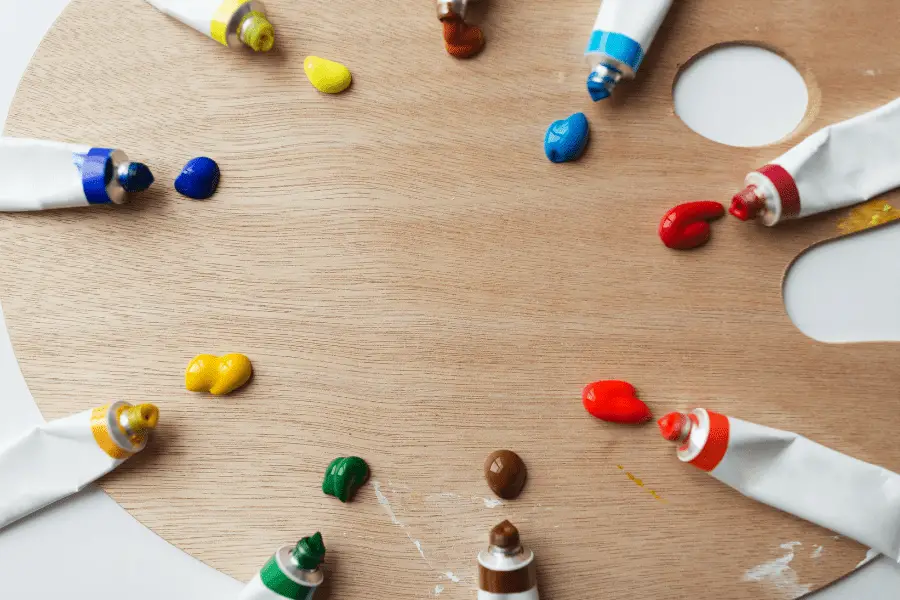Acrylic paint is one of the most versatile paints out there. It can be used on pretty much any surface, such as wood, metal, and even plastic. One of those surfaces also includes an already painted surface.
You may have a spray painted surface that you want to touch up, or even add texture to with acrylic paint. In this article we answer all your questions about using acrylic paint over spray paint, and many more!
So will acrylic paint stick to spray paint? Yes. Acrylic paint will stick to spray paint, provided that the conditions are right. A spray paint that is solvent based will be more likely to allow acrylic paint to stick to it, but only if the application is even.
Let’s read on!
Do Acrylic Paints Work Well on Spray Paint?

When it comes to applying acrylic paint on spray paint, you must first make sure to follow a few guidelines, to ensure it will actually work. This is due to several determining factors that can improve or reduce the ability of acrylic painting sticking to the spray paint.
My favorite and top pick for acrylic paint is Arteza. They have a huge selection of colors well as styles. I highly recommend this brand for all your acrylic paint projects.
If you are looking for a spray paint set, this one here is one of my top picks. It comes with 12 high quality colors, as a flat surface, and great coverage.
Type of Spray Paints to Use:
There are a few options to choose from for this step. Below we go over the most common types of paint. Solvent based spray paints, glossy paints, and matter to flat finish paints are the ones I would recommend.
Solvent Based Spray Paint
If the spray paint is solvent based, there is a greater likelihood of the acrylic paint sticking on it more permanently. However, if oil is on the surface, it would cause the acrylics to spread unevenly, like water’s response to oil.
It’s important that you shake the spray can before using it, in order to make sure that the oil mixes and settles in the whole mixture. This would improve the acrylic paint’s ability to stick on the surface sprayed by spray paint.
Glossy vs. Flat Spray Paint
Additionally, a matte or a flat spray paint is also a great surface for acrylic paints to stick to. If you are looking for matte acrylic paints, I recommend this one. It may come as a surprise, but acrylic paints also have the ability to stick to glossy spray paints, provided that the surface of the spray coat isn’t too oily.
There has been much debate in whether acrylics can stick to spray paints, and the answer is to evaluate the materials you have in order to judge whether they will mesh well.
How to Test if Your Acrylic Paints Can Stick to Spray Paint

Since there is a great variety and combinations of acrylic paint, and the ideal spray paint surface, it is always a great idea to have a trial run before starting your artwork. You want to make sure the materials you are using are compatible.
Here is a quick step by step guide to help you judge whether your acrylic paint will be able to stick to the spray paint.
- Read the labels on each medium before starting. It’s a good idea to evaluate the contents of acrylic paint and spray paint before starting your project. This will also help you save testing time in the future.
- Take a few pieces of raw canvas paper, and carefully tape them down on a flat surface. You can now experiment freely whether your acrylic paint can adhere to the surface of the spray paint.
- Make sure you practice using spray paints, since the distance of spraying matters. Having a mix of thick and thin coats can affect the sticking of the acrylic paints.
- Give the materials time to dry before testing it. Then you can carefully with the tip of your finger see if it’s dry. You can even remove the tape of the canvas and give it a few shakes to see how well the acrylic paint has stuck to the spray paint surface.
Testing the combination of acrylic paints and spray paints is a simple method that can used to make sure your paints will indeed stick, and work well with each other.
How To Seal Acrylic Painted Projects

Anytime you use acrylic paint on any surface, you want to make you seal it when you are done. Sealing your acrylic paint is an important step in making sure it won’t chip or flake later on. I always recommend Krylon Sealing Sprays, because they are of the highest quality, and they even protect against UV rays!
Sealing acrylic paint is recommended not only on a canvas, but on any painted surface like wood, plastic, or polymer clay. Acrylic paint is known to chip off or flake later on because it’s a water based paint. In another one of my articles, I talk about baking acrylic paint in the oven.
This step is done even after sealing your project. If you are painting on ceramic, clay, or even glass, you can bake your painted project to make the colors more vivid, as well as seal in the varnish.
Final Thoughts
Artists are known to use acrylic paint over their spray painted base for their artwork. Spray paints are convenient as they can cover a large surface area, in relatively little time. They also dry pretty quickly. If the spray painted surface is smooth and even, it will allow acrylic paint to stick on it without a problem.
Make sure to follow all the steps and guidelines in this article, to ensure you acrylic paint will properly stick to your spray paint. Also, don’t forget to check out my other articles for all your acrylic painting Q’s & A’s.
Happy painting!

